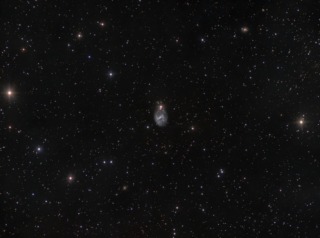
- Constellation: Pegasus
- Right Ascension: 23h 43m 54.4s
- Declination: +26° 04′ 32″
- Distance: 41 million
NGC 7741 A barred spiral located in the Pegasus constellation. A barred galaxy has a central bar with spiral arms trailing off of the bar. Many additional distant background galaxies are also in this image.
- Details
- Category: Galaxies
- Telescope: Explore Scientific 127 Refractor
- Camera: ZWO 1600 MM

- Constellation: Andromeda
- Right Ascension: 00h 40m 31.3s
- Declination: +40° 44′ 21″
- Distance: 2.5 million ly
Star Clouds of Andromeda featuring NGC 206 in the center, which is an OB association of hot O and B type stars numbering over 300 and stretching some 4,000 light years.
- Details
- Category: Galaxies
- Telescope: GSO RC10
- Camera: ZWO A071 Color

- Constellation: Hercules
- Right Ascension: 16h 05m 15.0s
- Declination: +17° 44′ 55″
- Distance: 500 million ly
Abell 2151 - Hercules Galaxy cluster. Over 200+ distant galaxies in this image. Galaxies are located 450-500 million light years away. Part of the larger Hercules super cluster.
Annotated image follows..
- Details
- Category: Galaxies
Read more: Hercules Galaxy Cluster (2019)
- Telescope: Explore Scientific 127 Refractor
- Camera: ZWO 1600 MM

- Constellation: Canes Venatici
- Right Ascension: 12h 30m 36.2s
- Declination: 41° 38′ 38″
- Distance: 25 ly
NGC 4490, commonly called the Cocoon Galaxy is a disrupted barred spiral galaxy located in the constellation of Canes Venatici. A smaller companion galaxy NGC 4485 has interacted with it in the past, creating a distorted galaxy and helping to produce rapid star formation.
- Details
- Category: Galaxies
- Telescope: Explore Scientific 127 Refractor
- Camera: Atik 314l+

- Constellation: Leo
- Right Ascension: 11h 17m
- Declination: +13°25′
- Distance: 35 million ly
Leo Triplet (M65, M66, NGC 3628) in my favorite orientation. The galaxies form part of the M66 Group. The three galaxies show signs of gravitational interaction in the past. M66 has drawn out spiral arms that show a high rate of star formation. NGC 3628 has a long tidal tail stream visible in deep exposure image, in addition to it's warped disk in our edge on view.
- Details
- Category: Galaxies
- Telescope: EDT 80mm Reftactor
- Camera: ZWO A071 Color

- Constellation: Ursa Major
- Right Ascension: 09h 55m 33.2s
- Declination: +69° 3′ 55″
- Distance: 12 million
Messier 81 is a spiral galaxy about half the size of the Milky Galaxy with a diameter of 90,000 light years, lies about 12 million light years away.
Messier 82 has a diameter of 37,000 light years and is classified as a star burst galaxy. It is undergoing rapid star formation most likely caused by gravitational interaction with M81 and NGC 3077.
NGC 3077 is an elliptical galaxy that appears to have been disrupted by M81 and M82. All of these galaxies belong to the Messier 81 galaxy group. One of the closer galaxy groups to our own Local group.
- Details
- Category: Galaxies
Read more: Messier 81 and Messier 82 (2019)
- Telescope: EDT 80mm Reftactor
- Camera: ZWO A071 Color